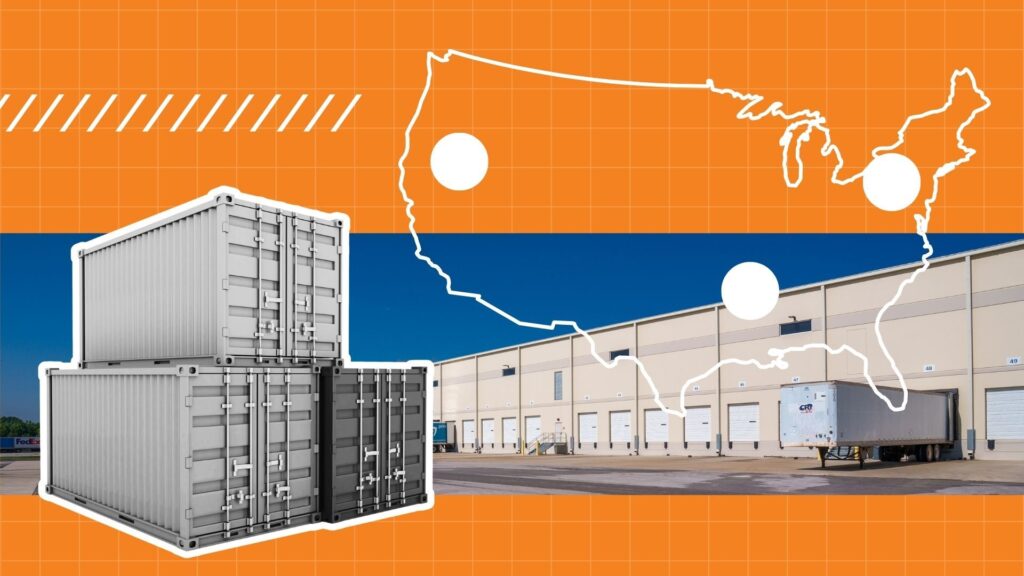Discover how multi-node fulfillment can streamline logistics, reduce costs, and meet customer demands for faster delivery in modern supply chains.
The Importance of Multi-Node Fulfillment in Optimizing Supply Chain Operations
The e-commerce industry is experiencing unprecedented growth, driving customer expectations to new heights. Today’s consumers demand personalized experiences, reliable service, seamless omnichannel experiences and rapid delivery. These ever-increasing expectations put significant pressure on businesses to optimize their supply chain operations and accelerate delivery times, making traditional fulfillment methods a thing of the past.
For e-commerce businesses, optimizing supply chain management is crucial for building resilience, reducing costs, and enhancing customer satisfaction. While various strategies exist, multi-node fulfillment has emerged as a leading solution to achieve these critical objectives.
Multi-node fulfillment is a sophisticated supply chain strategy that expands beyond a traditional single node operation. By strategically placing multiple micro-fulfillment centers across different locations, businesses can dramatically reduce shipping distances while offering faster, more reliable delivery options to their customers.
Supply Chain Dive recently partnered with Standvast to survey 151 supply chain executives and report on the Impact of Delivery Speed and Complexity on E-Commerce growth In this article, we’ll highlight some key takeaways, exploring why multi-node fulfillment is essential today and how businesses can leverage it to optimize their logistics and supply chain operations.
Understanding Multi-Node Fulfillment and Why It’s Critical Today
What is Multi-Node Fulfillment?
Multi-node fulfillment refers to the use of several strategically placed fulfillment centers across various locations (areas or regions) to store and ship orders.,They work to ship products from the nearest or most efficient location based on the customer’s address.
This option differs from the traditional single-node model, where the businesses haveone centralized fulfillment center to handle all shipment processes, often leading to longer delivery times and expensive shipping fees.
It’s worth emphasizing that even the most advanced single-node fulfillment model cannot meet modern customer expectations in today’s customer-centric and fast-paced e-commerce distribution environment, especially during peak seasons.
The Role of E-Commerce Growth in Changing Expectations
The e-commerce industry has experienced explosive growth in recent years, and is expected to grow from $6 trillion in 2023 to $8 trillion in 2027.. Like all dynamic industries, e-commerce continues to evolve, constantly reshaping customer expectations, demanding businesses to adapt.
Driven by the convenience offered by online shopping and advanced technology, the formerly acceptable 5 – 7-day delivery window is no longer desirable as consumers now prioritize convenience and speed. In fact, over 50% of customers now expect two-day delivery or less (Supply Chain Dive). Businesses that adapt to accelerated delivery expectations gain a significant competitive advantage in customer satisfaction and retention.
It is for this reason that multi-node fulfillment emerges as a strategic solution to meet these heightened expectations. By optimizing your supply chain operation through strategically placed fulfillment centers, businesses can offer a solution to drastically reduce shipping times, giving themselves a competitive edge in today’s fast-paced market.
The Business Case for Multi-Node Fulfillment
Fast Delivery Equals More Sales
Speedy delivery is not just a customer expectation—it directly impacts a company’s bottom line. In a recent survey of supply chain executives conducted by Standvast Fulfillment and Supply Chain Dive’s studioID, it was reported that a 47% uplift in median conversion rate was recorded as a result of fast delivery offered to customers (Supply Chain Dive).
This goes without saying that when customer demand for fast delivery is met, the turnaround for sales increases rapidly. This cannot be over-emphasized enough: Fast delivery is no longer a luxury—it’s a necessity if you are looking to thrive in today’s e-commerce landscape.

Cost-Efficiency Through Distribution
One of the key areas multi-node fulfillment shines is in its ability to enhance faster deliveries while keeping costs in check. 88% of companies are either already working with a logistics provider that uses multi-node fulfillment options or searching for one (Supply Chain Dive). This is because they recognize that multi-node fulfillment allows faster delivery at the same or lower cost.
The benefits of strategically placed fulfillment centers are numerous, some of which include a reduction in transit and delivery times,operational expenses, lower shipping costs and better stock levels.
Furthermore, multi-node fulfillment reduces the strain on any one facility, distributing workload more evenly across multiple locations.
Key Benefits of Multi-Node Fulfillment in Supply Chain Optimization
Proximity to Customers for Faster Shipping
Strategic proximity to customers through multi-node fulfillment delivers two significant advantages: enhanced customer satisfaction and increased revenue through improved customer loyalty.By distributing inventory across multiple locations, businesses can significantly reduce shipping distances and delivery times creating a competitive edge in supply chain operations.
According to the report, 58% of companies ensure that their fulfillment centers are in close proximity to their customers to reduce transit times, and it’s easy to see or know why.
The closer a product is to the customer, the less time and fuel are required to complete the delivery, making this strategy both cost-effective and environmentally friendly.
Improved Inventory Management
Real-time inventory tracking will help businesses ensure products are available at the right times and places. This is where AI/Machine Learning and Order Management Systems (OMS) can be very useful in predicting demand patterns, automating reorder points and orchestrating complex multi-location inventory movements.
At the moment, over 50% of business organizations rely on OMS to optimize their operations across different locations (Supply Chain Dive) highlighting its crucial role in modern supply chain success.
Scalability and Flexibility
The beauty of multi-node fulfillment lies in its scalability and flexibility. As customer demand fluctuates, especially during seasonal peaks or promotional events, this model allows businesses to adapt quickly. In essence, it allows them to scale efficiently without large infrastructure investments.
Rather than invest in warehouses that may sit underutilized for a long period of time, the multi-node model offers a network of smaller, strategically located fulfillment centers, allowing businesses to efficiently scale up or down without incurring significant losses or exorbitant costs while maintaining service levels.
Challenges of Multi-Node Fulfillment and How to Overcome Them
Multi-node fulfillment is not without its set of challenges. However, knowing the most common challenges and how to overcome them can make a significant difference in your supply chain operations and management.
Overcoming Operational Complexity
One of the challenges many companies face is managing several fulfillment centers, as this brings about issues in the management of complex operations. 44% of companies report having challenges in managing efficient processes, including picking and packing, across multiple locations (Supply Chain Dive).
Partnering with a third-party logistics (3PL) provider like Standvast offers a strategic solution. As a leading 3PL specializing in multi-node fulfillment, Standvast helps businesses streamline operations and reduce costs through comprehensive logistics solutions that simplify complex supply chain challenges.
By outsourcing the complex elements of multi-node fulfillment to a trusted 3PL partner like Standvast, you can focus on growth while ensuring that your logistics remain efficient.
Technology as a Solution
Another significant yet common challenge companies struggle with in their supply chain management and optimization is maintaining real-time visibility. 45% of businesses are struggling with real-time visibility of their inventory (Supply Chain Dive). This has led to understocking or overstocking, delays in shipping, and various inefficiencies in the supply chain.
The key to overcoming this challenge lies in using technology as a solution. Technology is one of the biggest drivers in the supply chain and using advanced technology tools like order management systems (OMS) and AI-powered tools to track your inventory in real-time is the best way to fix this issue.
These technological systems allow businesses to effectively track inventory levels, automate order routing, and manage multiple locations.
Collaborating with Standvast for Multi-Node Fulfillment Success
Standvast’s Network of Fulfillment Centers
When it comes to choosing a third-party logistics provider offering multi-node fulfillment models to work with, collaborating with Standvast is a reliable option. The success rate of Standvast implementing the multi-node fulfillment model to optimize the supply chain operations of businesses is at an all-time high and counting.
With a robust network of fulfillment centers, far and wide, Standvast helps businesses meet the fast delivery demands of their customers without the exorbitant investment in building or acquiring multiple warehouses.
With Standvast, that is just the tip of the iceberg. They offer shared services to enable businesses to reduce cost and scale flexibly with their scalable solutions. The end-to-end fulfillment solutions they also provide ensure that businesses can focus on growth while their logistics are handled by experts using the successful multi-node model.Are you ready to optimize your supply chain and bountifully reap its fruit? Partner with Standvast to implement multi-node strategies to your supply chain process and meet the growing demands of your customers. It is important to remember this: Multi-node fulfillment is not a luxury or a “could-have”—it’s a necessity and a “must-have.”
Get in touch with us for more information, and check out our blog and resources for more on multi-node fulfillment and supply chain.
P.S. Interested in learning more about our report with Supply Chain Dive?
